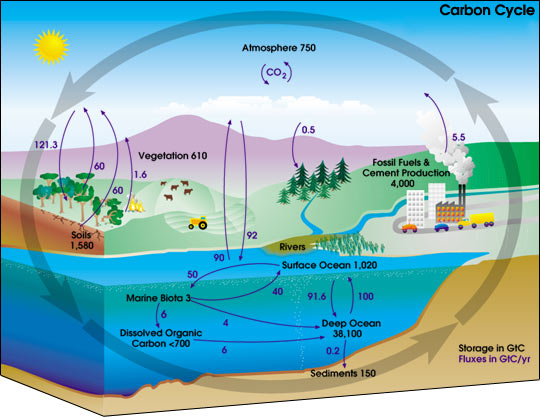An ecosystem model can be very simple or very complex depending on the questions being examined. For example, a graphical model like the one below can be very useful to help us figure out what the various components are in an ecosystem and how they are related, but they are not very useful in predicting future conditions. Much more complex models are needed to attempt to predict what will happen to an ecosystem under different conditions. Even the relatively complex carbon cycle illustrated below is probably not detailed enough to actually predict future conditions if one part of the ecosystem changed. In order to do that, you need to not only know which compartments are linked, but what factors control the flow of nutrients of energy among the various ecosystem components.

Components of Ecosytem Models
Since we are building a simple ecosystem model, we are lumping all tree species into one compartment, all understory plants into one component, etc. However, depending on the intended purpose of a model, you may need to split these components even further. For example, in most forests there are different layers distinguished by tree height. These layers are known as the canopy, sub-canopy, saplings, and seedlings. These features, called the forest structure can vary greatly from forest to forests… read more. Depending on the goals or intended use of your model, each layer in the forest could be a distinct component of the ecosystem model.
The specific species of trees present could be separate components of an even more complex forest ecosystem model. If a forest can be defined as an ecosystem dominated by trees, then hardwood forests can be defined as forests dominated by broad-leaved, deciduous trees. Species like Sugar Maple, Oaks, Basswood or Beech dominate rather than the needle-leafed, conifer tree species like White and Red Pine, Spruce, and Balsam Fir. Various hardwood forests as well as mixed hardwood-conifer forests are common across the Great Lakes region, unlike the Pacific Northwest and the drier mountain and desert regions to the west and southwest where conifer dominated forests are more common.
Connections in Ecosytem Models
The particular way that components are connected is one of the features that distinguish an Ecosystem Model from the more familiar and commonly used Conceptual Diagram (sometimes referred to as a “concept map”). In an Ecosystem Model, the connections between component parts always represent the movement (or flux) of nutrients or energy among components, while in a Conceptual diagram the connections between the ecosystem components may illustrate many different ways in which these components are related to each other.
For example, in a Conceptual Diagram connecting trees to people, it makes sense that people use lumber from trees. However, from the perspective of an ecosystem model, no transfer of energy or nutrients has occurred between the trees and people, because the nutrients & energy are still in the tree (lumber).

In an Ecosystem Model connecting people and trees, the connection must be one that actually transfers nutrients or energy from one component to the other. For example:
People harvesting timber or “using timber” does not move energy or nutrients into the people. But, when people EAT something from a tree, like maple syrup, then energy & nutrients are transferred from the tree component to the people component.
